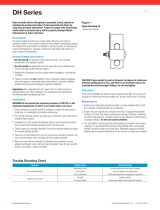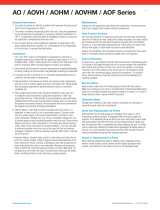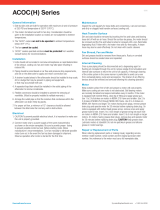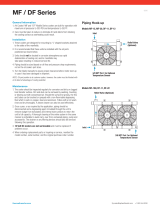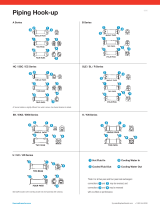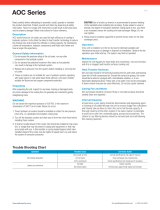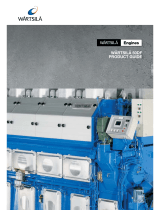
thermaltransfer.com ttp-sales@apiheattransfer.com +1.262.554.8330
CORE ASSEMBLY/ MOTOR
General Information
1. COL oil coolers are built for operation with maximum oil pressure of
250 PSIG (17.2 BAR) and temperatures of 300°F (148°C) without filter /
230°F (110°C) with filter. Maximum oil viscosity for P-BAR core is 150 cSt
without filter / 95 cSt with filter. Maximum oil viscosity for T-BAR core is
320 cSt without filter / 95 cSt with filter.
2. The motors furnished are built for fan duty. Consideration should be given to
the installation location so motors are not subjected to extreme temperatures
or additional static pressure restrictions above that of the core.
3. Oil coolers are not to be operated in ambient temperatures below 35°F (1°C).
4. The fan cannot be cycled.
5. Coolers operated outdoors must be protected from weather. Consult
factory for recommendations.
6. If the unit is to be stored for longer than 6 months, the unit should be oil
flushed and all openings sealed with plastic plugs.
Installation
1. Air cooled oil coolers should not be located in corrosive atmospheres
as rapid deterioration of fan shroud, cooling coil, fan and motor may
take place.
2. The cooler should be mounted securely with its designed mounts.
3. Piping should be sized based on oil flow and pressure drop requirements,
not on the oil cooler’s supply and return connection sizes.
4. A filter located ahead of the oil cooler should be installed to trap dirt
or sludge that may be present in piping and equipment, or that may
accumulate with use.
5. A temperature controlled bypass valve is recommended for cold start-up.
The bypass valve should be plumbed at the oil inlet to the unit in-order to
function properly. Failure to plumb the bypass valve correctly could result
in damage or failure of the unit.
6. Flexible connectors should be installed to prevent the stressing of
manifolds. (Must be properly installed to validate warranty)
7. For proper air flow, a minimum of 12" (305mm) should be allowed between
the oil cooler fan and any walls or obstructions. Sufficient ventilation is
required in closed areas.
Electrical
1. Use CAUTION to prevent possible electrical shock, it is important to
make sure this unit is properly grounded.
2. Connect motor only to a power supply of the same characteristics as
shown on the motor nameplate. Be sure to provide proper fusing to prevent
possible motor burnout. Before starting motor, follow manufacturer’s
recommendations. Turn fan manually to eliminate possible motor burnout
in the event the fan has been damaged in shipment. Observe operation
after motor is started for the first time.
Maintenance
Inspect the unit regularly for loose bolts and connections, rust and corrosion,
and dirty or clogged heat transfer surfaces (cooling coil).
Heat Transfer Surface
Dirt and dust should be removed by brushing the fins and tubes and blowing
loose dirt off with an air hose. Should the surface be greasy, the motor should
be removed and the fins and tubes brushed or sprayed with a non-flammable
degreasing fluid. Follow with a hot water rinse and dry thoroughly. A steam
hose may also be used effectively.
Do not clean with caustic cleaners. Only cleaners compatible for use with
aluminum are to be used.
Fan Shroud, Fan and Motor
Dirt and grease should be removed from these parts. Rusty or corroded
surfaces should be sanded clean and repainted.
Internal Cleaning
Once a year piping should be disconnected and a degreasing agent or
flushing oil circulated through the unit to remove sludge from turbulators and
internal tube surfaces to return the unit to full capacity. Do not clean with
caustic cleaners. Only cleaners compatible for use with aluminum are to
be used. A thorough cleaning of the entire system in the same manner is
preferable to avoid carry-over from uncleaned piping, pump and accessories.
The strainer of any filtering devices should be removed and serviced following
this cleaning operation.
Motor
Keep outside surface free of dirt and grease so motor will cool properly. All
motors use sealed shaft bearings. As a result, they do not require greasing.
Repair or Replacement of Parts
When ordering replacement parts or making inquiry regarding service,
mention model number, serial number and the original purchase order
number. Any reference to the motor must carry full nameplate data.
FILTER
Installation
▪Check that the pressure value of the selected filter is higher than the
system’s maximum operating pressure (the maximum pressure value
is shown on the data plate).
▪Check that the filter body contains the filter cartridge.
▪Check that the operating fluid is compatible with the material of the
body, cartridge, and seals.
▪Secure the filter using the relevant threaded holes, to rigid brackets.
Rigid installation makes it possible to unscrew the housing without
introducing flexing of the hydraulic fittings, limiting any points of stress
transfer. Install the filter in an accessible position for correct and trouble-
free maintenance and visibility.
▪Start the machine and check for the absence of oil leaks from the filter
and relative fittings.
▪Repeat the visual inspection when the system arrives at the operating
temperature of the oil.
Maintenance
▪All maintenance operations must be performed only by suitably trained
personnel.
▪The hydraulic system must be depressurized before performing
maintenance operations (except in the case of LMD duplex filters)
▪Maintenance must be carried out using suitable tools and containers
to collect the fluid contained in the filter body. Spent fluids must be
disposed of in compliance with statutory legislation.
▪Do not use naked flames during maintenance operations.
▪Use the utmost caution in relation to the temperature of the fluid. High
temperatures can lead to residual pressure with resulting undesirable
movements of mechanical parts.
Changing the Filter Element
▪The date on which the filter elements are changed must be entered
in the machine data sheet.
▪Spare parts installed must be in compliance with the specifications
given in the machine operating and maintenance manual.
▪Filter bodies and tools must be thoroughly cleaned prior to each
maintenance operation.
COL Series 0916

thermaltransfer.com ttp-sales@apiheattransfer.com +1.262.554.8330
▪After having opened the filter to change the filter element, check the
condition of the seals and renew them if necessary. Clean thoroughly
before reassembling.
Changing the Filter Procedure
▪Depressurize the system and clean the filter.
▪Unscrew the oil drain plug collecting the fluid in a suitable container. When
the operation is terminated, screw the plug by tightening it fully down and
check the condition of the seal. Unscrew housing using the appropriate
tools and extract the filter element.
▪Collect the spent oil and cartridge in a suitable container and dispose of
them in compliance with statutory legislation
▪WARNING! To avoid damaging the components, clean seals, surfaces,
and threads of the housing and the head.
▪Lubricate the filter element seal with the operating fluid. Insert the filter
element in the filter housing. Insert the cartridge in the head spigot.
▪Check the condition of seals if renewing, lubricate the new seals with the
operating fluid before installing.
▪Screw the housing onto the head using the correct tool. WARNING:
Screw the housing fully home into the head “DO NOT APPLY EXCESSIVE
TIGHTENING TORQUE”.
▪Start the machine and check for the absence of leaks. Repeat the check
when the machine has reached its operating temperature.
PUMP
Corrosion
Fretting: To reduce the corrosion due to fretting effect we recommend to
grease the motor shaft with dedicated products (samples: lubricants based
on MoS2, Loctite® 8008, Molykote® G-n plus, Turmopast® MA2).
Fretting: To reduce the corrosion due to fretting effect, we recommend
to check the electric motor ground connection and to check that the shaft
residual currents are within the norms.
Leakage Prevention: In case of wear of shaft seal to avoid leakage, all
pump flanges with hallow shaft have a threaded ¼" GAS thread that can
be used for drainage connection to the tank
Piping/Valves
▪Piping connected to pump MUST be independently supported and not
allowed to impose strains on pump casing including allowing for expansion
and contraction due to pressure and temperature changes.
▪To prevent foaming and air entrainment, all return lines in re-circulating
systems should end well below liquid surface in reservoir. Bypass liquid
from relief pressure and flow control valves should be returned to source
(tank, reservoir, etc.), NOT to pump inlet line.
▪Shut-off valves should be installed in both the suction and discharge
lines so pump can be hydraulically isolated for service or removal.
All new piping should be flushed clean before connecting to pump
▪Pipe strain will distort a pump. This could lead to pump and
piping malfunction or failure.
▪Return lines piped back to pump can cause excessive temperature
rise at pump which could result in catastrophic pump failure.
▪Use relief valves to protect pumps from overpressure. They need to be
connected to pump discharge lines as close to pumps as possible and
with no other valves between pumps and relief valves. Relief valve settings
should be set as low as practical.
▪DO NOT set relief valve higher than maximum pressure rating of pump,
including pressure accumulation at 100% bypass. Relief valve return lines
should NOT be piped into pump inlet lines because they can produce a
loop that will overheat pump. This pump is a positive displacement type. It
will deliver (or attempt to deliver) flow regardless of back-pressure on unit.
Failure to provide pump overpressure protection can cause pump or driver
malfunction and/or rupture of pump and/or piping.
Suction Line/ Suction Strainer/Filter
▪The suction line should be designed so pump inlet pressure, measured
at pump inlet flange, is greater than or equal to the minimum required pump
inlet pressure (also referred to as Net Positive Inlet Pressure Required or
(NPIPR). Velocity in suction line should be kept within 1.6-4 ft/s (0,5-
1,2 m/s). Suction line length should be as short as possible and equal to
or larger than pump's inlet size. All joints in suction line must be tight and
sealed. If pump cannot be located below liquid level in reservoir, it necessary
either to position the suction or install a foot valve so liquid cannot drain from
pump while it is shut down. When pump is mounted vertically with drive shaft
upward, or mounted horizontally with inlet port opening other than facing
upward, a foot valve or liquid trap should be installed in suction line to prevent
draining. The suction line should be filled before pump start-up.
▪DO NOT operate the pump without liquid or under severe
cavitation
▪Pump life is related to liquid cleanliness. Suction strainers or filters
should be installed in all systems to prevent entry of large contaminants
into pump.
▪The purpose of a suction strainer or filter is for basic protection of internal
pumping elements. It should be installed immediately ahead of inlet port. This
location should provide for easy cleaning or replacement of strainer element.
Appropriate gages or instrumentation should be provided to monitor pump
pressure. Pressure drop across a dirty strainer must not allow inlet pressure
to fall below NPIPR. The pressure drop across the strainer should preferably
not exceed 1.45 PSIG (0.1 BAR) at maximum flow rate and normal operating
viscosity. General guidelines for strainer sizing are as follows:
▪When pumping relatively clean viscous liquids (over 1000 cSt), use 10
to 12 mesh screens or those with about 1/16 inch (1,5mm) openings.
▪When pumping relatively clean light liquids such as distillate fuels,
hydraulic oil and light lube oils, use suction strainers of 100 to 200
mesh.
▪When pumping heavy crude oils, use 5 to 6 mesh strainer screens or
those with or about 1/8 inch (3mm) openings.
▪When pumping relatively clean distillate fuels in high pressure fuel
supply systems, use 25 micron “absolute” filters for three screw pumps
and 10 micron “absolute” filters for gear pumps.
▪Make sure size/capacity of strainer or filter is adequate to prevent
having to clean or replace elements too frequently.
Gauges
Pressure and temperature gauges are recommended for monitoring the
pump’s operating conditions. These gauges should be easily readable and
placed as close as possible to pump’s inlet and outlet flanges
Pumped Liquids
NEVER operate a pump with straight water (water/glycol is okay). The pump
is designed for liquids having general characteristics of oil. In closed or
re-circulating systems, check liquid level in tank before and after start-up to
be sure it is within operating limits. If initial liquid level is low, or if it drops
as system fills during start-up or pumping operations, add sufficient clean
liquid to tank to bring liquid to its normal operating level. Only use liquid
recommended or approved for use with the equipment. Regular checks
should be made on the condition of the liquid. In closed systems, follow
supplier’s recommendations for maintaining liquid and establishing when
liquid is to be changed. Be sure temperature is controlled so liquid cannot fall
below its minimum allowable viscosity which occurs at its maximum operating
temperature. Also, ensure that maximum viscosity at cold start-up does not
cause pump inlet pressure to fall below its minimum required value.
NEVER operate a pump without liquid in it!
Operate only on liquids approved for use with pump.
COL Series continued
/

